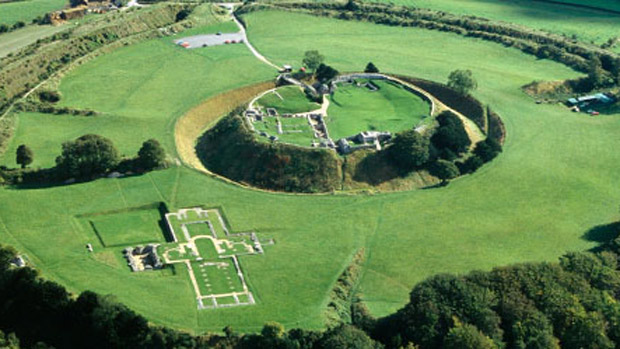Medieval palace discovered underground in Wiltshire
Discovery reveals 'monumental scale' of building work taking place in the early 12th century

Archaeologists in Wiltshire have discovered what is believed to be one of the largest medieval royal palaces ever found underground in Britain.
Ground-penetrating x-ray technology is being used to map a long-vanished Norman city that has remained under a field for more than 700 years inside the huge earthwork defences of an Iron Age hill fort at Old Sarum in Wiltshire.
During the geophysical survey, archaeologists from the University of Southampton discovered a 170m-long, 65m-wide complex, arranged around a large courtyard. It is believed to have had a 60m-long great hall, as well as a substantial tower and multi-story buildings with upper floors.
The Week
Escape your echo chamber. Get the facts behind the news, plus analysis from multiple perspectives.

Sign up for The Week's Free Newsletters
From our morning news briefing to a weekly Good News Newsletter, get the best of The Week delivered directly to your inbox.
From our morning news briefing to a weekly Good News Newsletter, get the best of The Week delivered directly to your inbox.
"The location, design and size of the courtyarded complex strongly suggests that it was a palace, probably a royal one," says Dr Edward Impey, director-general of the Royal Armouries and an expert on high status medieval buildings. "The prime candidate for constructing it is perhaps Henry I sometime in the early 12th century."
Professor David Bates of the University of East Anglia, a historian and leading authority on Norman England, described it as a "discovery of immense importance" that reveals the "monumental scale of building work taking place in the earlier 12th century".
The medieval city of Old Sarum was largely founded by Henry I's father, William the Conqueror, around the same time that cathedrals were being built in Westminster, Winchester, Gloucester and York, says The Independent's archaeology correspondent David Keys.
But by the early 13th century Old Sarum was moved "lock, stock and barrel" to Salisbury, two and a half miles to the south, because it was too cramped and exposed to the elements.
A free daily email with the biggest news stories of the day – and the best features from TheWeek.com
"Even the masonry of the great Norman cathedral and other structures were transported and re-used to construct a new cathedral and other buildings in the newly established city of Salisbury," says Keys. "Only now is geophysical survey work beginning to re-discover the long-vanished city – and what appears to have been its truly massive royal palace."
-
 Prickly pear juice recipe
Prickly pear juice recipeThe Week Recommends Jewel-toned, natural juice is a thirst-quenching treat
-
 The truth about vitamin supplements
The truth about vitamin supplementsThe Explainer UK industry worth £559 million but scientific evidence of health benefits is ‘complicated’
-
 Is convenience culture killing community?
Is convenience culture killing community?In The Spotlight A decline in emotional intelligence could be responsible for a diminished sense of belonging
-
 Home Office worker accused of spiking mistress’s drink with abortion drug
Home Office worker accused of spiking mistress’s drink with abortion drugSpeed Read Darren Burke had failed to convince his girlfriend to terminate pregnancy
-
 In hock to Moscow: exploring Germany’s woeful energy policy
In hock to Moscow: exploring Germany’s woeful energy policySpeed Read Don’t expect Berlin to wean itself off Russian gas any time soon
-
 Were Covid restrictions dropped too soon?
Were Covid restrictions dropped too soon?Speed Read ‘Living with Covid’ is already proving problematic – just look at the travel chaos this week
-
 Inclusive Britain: a new strategy for tackling racism in the UK
Inclusive Britain: a new strategy for tackling racism in the UKSpeed Read Government has revealed action plan setting out 74 steps that ministers will take
-
 Sandy Hook families vs. Remington: a small victory over the gunmakers
Sandy Hook families vs. Remington: a small victory over the gunmakersSpeed Read Last week the families settled a lawsuit for $73m against the manufacturer
-
 Farmers vs. walkers: the battle over ‘Britain’s green and pleasant land’
Farmers vs. walkers: the battle over ‘Britain’s green and pleasant land’Speed Read Updated Countryside Code tells farmers: ‘be nice, say hello, share the space’
-
 Motherhood: why are we putting it off?
Motherhood: why are we putting it off?Speed Read Stats show around 50% of women in England and Wales now don’t have children by 30
-
 Anti-Semitism in America: a case of double standards?
Anti-Semitism in America: a case of double standards?Speed Read Officials were strikingly reluctant to link Texas synagogue attack to anti-Semitism